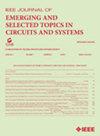Real-Time Quality- and Energy-Aware Bitrate Ladder Construction for Live Video Streaming
IF 3.8
2区 工程技术
Q2 ENGINEERING, ELECTRICAL & ELECTRONIC
IEEE Journal on Emerging and Selected Topics in Circuits and Systems
Pub Date : 2025-02-07
DOI:10.1109/JETCAS.2025.3539948
引用次数: 0
Abstract
Live video streaming’s growing demand for high-quality content has resulted in significant energy consumption, creating challenges for sustainable media delivery. Traditional adaptive video streaming approaches rely on the over-provisioning of resources leading to a fixed bitrate ladder, which is often inefficient for the heterogeneous set of use cases and video content. Although dynamic approaches like per-title encoding optimize the bitrate ladder for each video, they mainly target video-on-demand to avoid latency and fail to address energy consumption. In this paper, we present LiveESTR, a method for building a quality- and energy-aware bitrate ladder for live video streaming. LiveESTR eliminates the need for exhaustive video encoding processes on the server side, ensuring that the bitrate ladder construction process is fast and energy efficient. A lightweight model for multi-label classification, along with a lookup table, is utilized to estimate the optimized resolution-bitrate pair in the bitrate ladder. Furthermore, both spatial and temporal resolutions are supported to achieve high energy savings while preserving compression efficiency. Therefore, a tunable parameter实时视频流的质量和能量感知比特率阶梯结构
直播视频流对高质量内容的需求不断增长,导致了大量的能源消耗,为可持续的媒体交付带来了挑战。传统的自适应视频流方法依赖于资源的过度供应,导致固定的比特率阶梯,这对于异构的用例和视频内容集通常是低效的。虽然像按标题编码这样的动态方法优化了每个视频的比特率阶梯,但它们主要针对视频点播,以避免延迟,无法解决能耗问题。在本文中,我们提出了LiveESTR,一种为实时视频流构建质量和能量感知比特率阶梯的方法。LiveESTR消除了在服务器端进行详尽的视频编码过程的需要,确保了比特率阶梯构建过程的快速和节能。使用轻量级的多标签分类模型和查找表来估计比特率阶梯中优化的分辨率-比特率对。此外,支持空间和时间分辨率,在保持压缩效率的同时实现高能量节约。因此,引入可调参数$\lambda $和阈值$\tau $来平衡压缩/质量和能源效率之间的权衡。实验结果表明,LiveESTR将编码器和解码器的能耗降低了74.6% % and 29.7 %, with only a 2.1 % increase in Bjøntegaard Delta Rate (BD-Rate) compared to traditional per-title encoding. Furthermore, it is shown that by increasing $\lambda $ to prioritize video quality, LiveESTR achieves 2.2 % better compression efficiency in terms of BD-Rate while still reducing decoder energy consumption by 7.5 %.
本文章由计算机程序翻译,如有差异,请以英文原文为准。
求助全文
约1分钟内获得全文
求助全文
来源期刊

IEEE Journal on Emerging and Selected Topics in Circuits and Systems
ENGINEERING, ELECTRICAL & ELECTRONIC-
CiteScore
8.50
自引率
2.20%
发文量
86
期刊介绍:
The IEEE Journal on Emerging and Selected Topics in Circuits and Systems is published quarterly and solicits, with particular emphasis on emerging areas, special issues on topics that cover the entire scope of the IEEE Circuits and Systems (CAS) Society, namely the theory, analysis, design, tools, and implementation of circuits and systems, spanning their theoretical foundations, applications, and architectures for signal and information processing.
 求助内容:
求助内容: 应助结果提醒方式:
应助结果提醒方式:


